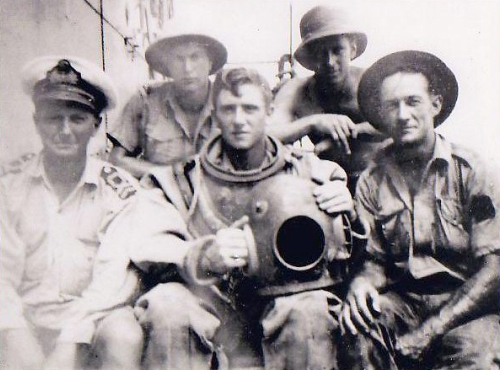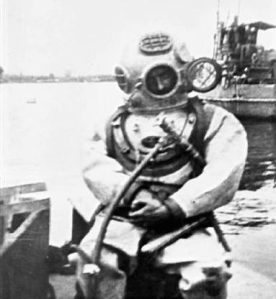Filed in: War History – Author: JF Dowsett
Of all the stories of the Royal Australian Navy during the Second World War, few have explored what went on beneath the sea; not well-known drama of submarine warfare, but the first-hand fight with sunken wrecks, enemy mines and unexploded torpedoes. This was a war waged by the Navy’s own fearless clearance divers from beginning to end. It was a dangerous game, played with full knowledge of the frightful consequences of the slightest false move.

Royal Australian Navy divers in Darwin in 1942. (Image via RANCDA)
In 1941, during the Battle of Crete, a German torpedo bomber swept in low over a harbour mouth in Malta where the light cruiser HMAS Perth was moored and launched its deadly load. The torpedo struck at such a sharp angle that it plunged straight through the water and ploughed into the muddy bottom without exploding. The ‘fish’ – as naval servicemen called them – was still live, its nose propellers having had time to revolve and screw the detonator hard up against the 500 lb (220kg) of explosive primed within its warhead. The smallest shock, even the concussion from another exploding bomb, would have set it off with the same devastating effect as a naval mine. It had to be removed, and the Navy called for volunteers.

Light cruiser HMAS Perth. (Image via RANCDA)
A petty officer from the Perth took the job. He clambered stiffly over the side of the diving boat and dropped expertly from the rope ladder into harbour waters stirred to murkiness by the raid just over. Being an experienced clearance diver, he’d seen what the savage concussion of depth charges had done to a submarine’s steel hull, their enormous force transmitted through and augmented by the water.
He found the torpedo easily enough, its nose embedded in thick glutinous mud, and set to work attaching the lowered grappling hook. Working against time, every moment tense with the possibility of being blown to pieces, the diver secured his hook and ordered the surface crew, “Hoist carefully!” As they took the weight up top, the long shape eased slowly from its sheath of slime. He backed away as the blades of its propellers swung towards him: the least touch would mean oblivion. Just as the torpedo swayed up through the water, the dread words came over his phone: “Air-raid, red! Air-raid, red!” Yet another air raid was imminent. They hauled him in over the side as the first bombs fell and headed for the shore, the diver sprawled in the bottom of the boat still helmeted and shod.

Bandar Shapur, Iran. c. September 1941. A tug helps to position the German ship Hohenfels to anchor next to HMS Kanimbla. This was part of an operation by Force B, in which HMS Kanimbla took part, manned by RAN personnel. (Donor W. L. G. Adams)
Aboard the Armed Merchant Cruiser HMAS Kanimbla in the Persian Gulf, Petty Officer and clearance diver JT ‘Jack’ Humphries would be awarded the George Medal for his work in salvaging the submerged hull of the scuttled German merchantman SS Hohenfels. Humphries ventured alone into the bowels of the ship to close all openings and valves which the vacating sailors had left open. Here existed circumstances which called for the highest degree of cold courage to overcome them. The fearless diver, because of the innumerable obstacles to his life-line in the engine room, had to secure it to a stanchion and thus work entirely alone. He now had no means of signalling if he were in trouble. Stumbling over greasy engines and boilers into every corner where there was likely to be a valve – necessitated by the Germans deliberately falsifying their ship’s plans – Humphries groped his way as the tide threatened to run out. Streaming through bulkheads and passages at seven knots in this narrow neck of the Gulf, it threatened to roll him to his death. To prevent being washed away, he gripped stanchions and cylinder pistons with both arms; then, when the tide slackened again, he resumed work. Due almost entirely to the efforts of Petty Officer Humphries, that valuable ship was floated and reclaimed.
Aboard the HMAS Hobart in Alexandria, the crew watched a huge black shape, swinging slowly beneath its parachute, drop from an unseen bomber above the clouds and plop into the harbour. It was a parachute mine; there were seven different ways it could be exploded, and as they watched they knew its delayed action fuse timer was ticking nearer to zero. The Navy diving boat darted quickly but carefully over the spot and killed its engine, as even the pulsing beat of its propeller transmitted through the water could have exploded the menacing payload of high explosive. The diver had no means of knowing if the mine was rigged to detonate on an attempt to lift it. He found the mine lying in two feet of sediment and, up to his knees in mud, worked carefully towards it. The mine had to be hoisted or exploded under water. He found it was too precarious and would have to be the latter. So, in imminent danger of going up with the mine, he scooped a shallow trench beneath its belly. He then placed in the trench a tube of gelignite and signaled to be hoisted up himself. They drew back, paying out the battery wire as they went, and pressed the plunger. The mine exploded with a roar and tore itself apart in a spreading cascade of water.
There were not only the hazards of warfare to contend with. Always present, always in the forefront of the diver’s consciousness, was the natural danger from the pressure of tons of water around him and the strange tricks that not a lifetime of experience could completely nullify.

RAN clearance diver testing an American dive suit. HMAS Madang, 1945
Once while testing a new dive suit, an Australian diver was working on the bottom of the hull of a British submarine. Working busily a hacksaw, he failed to notice a small hole that started in his suit under the left arm. Gradually, with the pressure of air from within, the slit widened and the air streamed out in increasing volume. In less than a minute the diver found the greater mass of air in his lower body swiftly lifting his legs above his head. Soon, completely helpless, he was hanging upside down in thirty feet of green water. Then the sea began to trickle slowly through the exposed hole, past his chin and eyes, inexorably filling the top of his helmet. Seawater dangerously short-circuited his telephone line, leaving him without communication, and in his strange upside-down orientation he found it impossible to find his signal line. He felt the cold of the water creeping up around his head, up to his ears. In a minute it would fill his nose and mouth. Then the attendant up top, having lost communication, decided to haul him up. The diver, half-conscious, managed to grasp his shot-line as the strain came on his rope, and hoist his head above the level of his feet as the water fell over his shoulders to the bottom of his suit.
The Clearance Diving Branch of the Royal Australian Navy was officially formed after the war in 1951. During the Branch’s formative years, the divers developed their ‘can do easy’ attitude performing a diverse range of diving, Explosive Ordnance Disposal (EOD) and salvage related tasks. With obsolete equipment and limited support from the Naval command structure, they had to develop and hone their skills in house. This necessitated an extreme level of improvisation which led to developing skills and breeding an independence in the Clearance Diving Branch which makes the Australian Clearance Diver of today quite unique in the world of Military Diving.
Indeed, as a result of this demanding selection and training, modern Clearance Divers have served in the counter-terrorist Squadrons of the Australian SAS Regiment and continue to serve in that role with the Commando Regiment, 4RAR (TAG East). Small numbers of divers currently serve as EOD specialists in Afghanistan and elsewhere around the globe. Clearance divers are also used in high risk ship boardings, such as suspected pirate vessels in Somalia and those used by human traffickers in Australian waters.
These are the men who voluntarily add the perils of underwater work to the scales already weighted against them.
Amazing dedication to go down in one of those suits back then. Such courage! Excellent post.
LikeLike
Yes, and as the equipment and technology was in it’s infancy, these guys were pioneers as well. Thanks for reading, GP.
LikeLiked by 1 person
A scary job at the best of times but underwater – that takes some beating! Very interesting to read.
LikeLike
It was certainly a time that redefined bravery and fearlessness. Glad you liked the article, thanks for reading.
LikeLiked by 1 person
Great post. So interesting.
LikeLike
Thank you!
LikeLiked by 1 person
You are welcome!
LikeLike
Such an amazing courage and great training. Unbelievable what these people had to endure.
LikeLike
Reblogged this on quirkywritingcorner.
LikeLike
RF, saw this article and thought of you my friend!
http://taskandpurpose.com/wwii-era-planes-bring-rush-memories-veterans-flew/?utm_source=newsletter&utm_medium=email&utm_campaign=tp-today
LikeLiked by 1 person
You’ll be happy to know I just recently discovered the Task&Purpose blog. Some really great stuff there. I gotta say, your blogs have lead me to new understanding of military life and weapons/security culture in the US. It’s so very misunderstood from the outside.
LikeLike